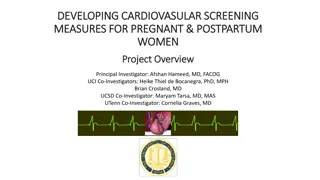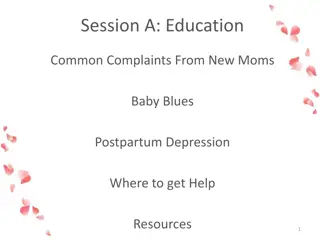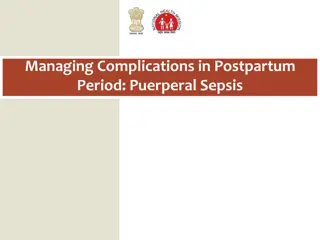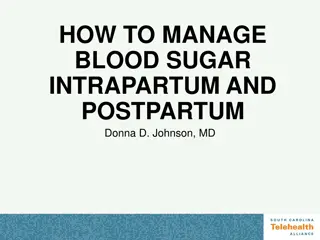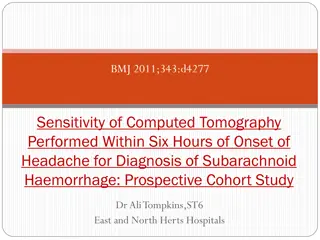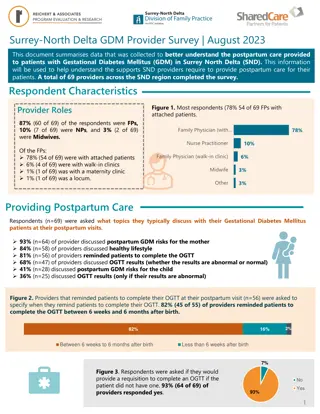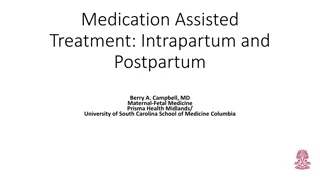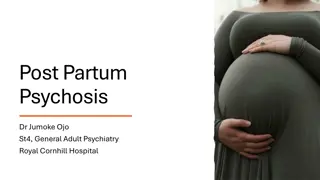Postpartum Haemorrhage: Causes, Management, and Learning Objectives
This content delves into postpartum haemorrhage (PPH), covering its definition, causes, management measures for minor and major PPH, and learning objectives related to PPH understanding and risk factors. Understanding PPH is crucial in obstetrics and gynecology practice.
Download Presentation

Please find below an Image/Link to download the presentation.
The content on the website is provided AS IS for your information and personal use only. It may not be sold, licensed, or shared on other websites without obtaining consent from the author.If you encounter any issues during the download, it is possible that the publisher has removed the file from their server.
You are allowed to download the files provided on this website for personal or commercial use, subject to the condition that they are used lawfully. All files are the property of their respective owners.
The content on the website is provided AS IS for your information and personal use only. It may not be sold, licensed, or shared on other websites without obtaining consent from the author.
E N D
Presentation Transcript
University of Basrah Al-Zahraa Medical College Ministry of higher Education and Scientific Research Academic year 2021-2022 5th year REPRODUCTIVE BLOCK Lecture Duration : 1 hour Postpartum haemorrhge Presented by Dr.RAYA MUSLIM AL HASSAN Rcog green top Block staff: Dr.Raya Muslim Al Hassan (module leader) Dr.Marwa Sadik (coleader) Dr. Abdul kareem Hussain Subber Dr.Alaa Hufdhi GYNAECOLOGY 20th EDITION by Ten Teachers
University of Basrah Al-Zahraa Medical College Ministry of higher Education and Scientific Research Learning objectives 1.To understand postpartum haemorrhage(PPH) 2.Identify the risk factors of PPH 3.TO know the proper management of PPH
University of Basrah Al-Zahraa Medical College Ministry of higher Education and Scientific Research PPH is the loss of 500 ml or more of blood from the genital tract within 24 hours of the birth of a baby until 12 weeks postnatally .It can be : a/minor (500 1000 ml) B/ major (more than 1000 ml). Primary ( bleeding within the first 24 hours of delivery) Secondary(after 24 hours until 12 weeks)
University of Basrah Al-Zahraa Medical College Ministry of higher Education and Scientific Research Causes of PPH It can be summarized in 4Ts: a/Tone( uterine inertia) which is the commonest cause,the risk factors are: Multiple pregnancy Previous PPH Failure to progress in second stage Prolonged third stage of labourTone General anaesthesia b/Trauma:perineal laceration/episiotomy c/Tissue: Retained placental,Placenta accrete d/thrombin preeclampsia
University of Basrah Al-Zahraa Medical College Ministry of higher Education and Scientific Research management Measures for minor PPH (blood loss 500 1000 ml) without clinical shock: intravenous access (one 14-gauge cannula) urgent venepuncture (20 ml) for: group and screen full blood count coagulation screen, includingfibrinogen pulse, respiratory rate and blood pressure recording every 15 minutes commence warmed crystalloid infusion.5.3.2 Measures for major PPH Full protocol for major PPH (blood loss greater than 1000 ml) and continuing to bleed or clinical shock A and B assess airway and breathing C evaluate circulation position the patient flat keep the woman warm using appropriate available measures
University of Basrah Al-Zahraa Medical College Ministry of higher Education and Scientific Research transfuse blood as soon as possible, if clinically required until blood is available, infuse up to 3.5 l of warmed clearfluids, initially 2 l of warmed isotonic crystalloid. Furthe rfluid resuscitation can continue with additional isotonic crystalloid or colloid(succinylated gelatin). Hydroxyethyl starch should not be used. the best equipment available should be used to achieve rapid warmed infusion of fluids special bloodfilters shouldnot be used, as they slow infusions. Treating the cause
University of Basrah Al-Zahraa Medical College Ministry of higher Education and Scientific Research Treatment of uterine inertia palpate the uterine fundus and rub it to stimulate contractions ( rubbing up the fundus ) ensure that the bladder is empty (Foley catheter, leave in place) oxytocin 5 iu by slow intravenous injection (may have repeat dose) ergometrine 0.5 mg by slow intravenous or intramuscular injection (contraindicated in women with hypertension) oxytocin infusion (40 iu in 500 ml isotonic crystalloids at 125 ml/hour) unless fluid restrictionis necessary carboprost 0.25 mg by intramuscular injection repeated at intervals of not less than 15 minutesto a maximum of eight doses (use with caution in women with asthma) misoprostol 800 micrograms sublingually. If drugs failed so proceed for surgical measures: Intrauterine balloon B-Lynch
University of Basrah Al-Zahraa Medical College Ministry of higher Education and Scientific Research Uterine message B.lunch sutures
University of Basrah Al-Zahraa Medical College Ministry of higher Education and Scientific Research Management of other causes
University of Basrah Al-Zahraa Medical College Ministry of higher Education and Scientific Research How should secondary PPH be managed?In women presenting with secondary PPH, an assessment of vaginal microbiology should beperformed (high vaginal and endocervical swabs) and appropriate use of antimicrobial therapyshould be initiated when endometritis is suspected.A pelvic ultrasound may help to exclude the presence of retained products of conception(RPOC),
University of Basrah Al-Zahraa Medical College Ministry of higher Education and Scientific Research complications Shock DIC Renal failure Sepsis death






